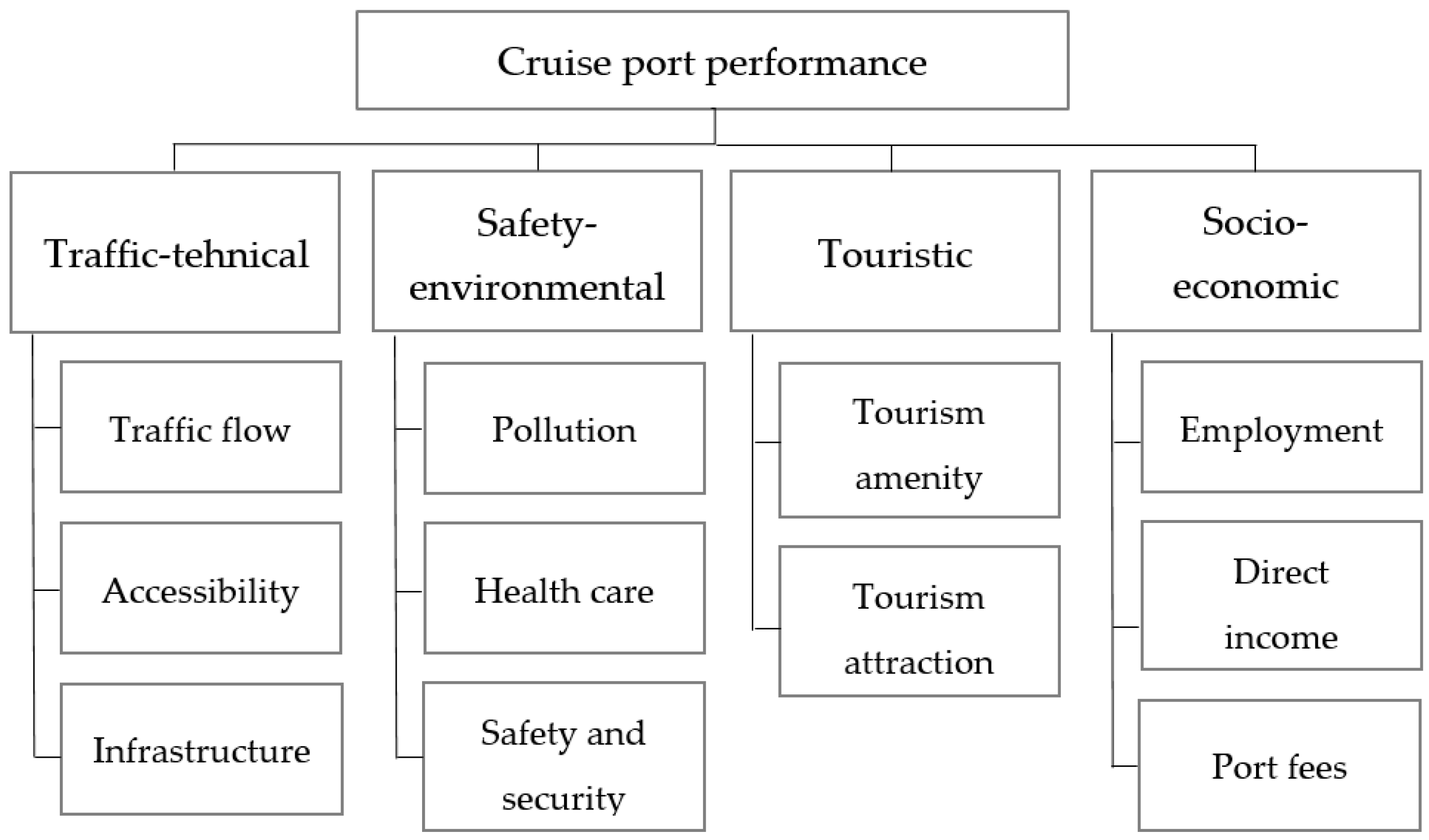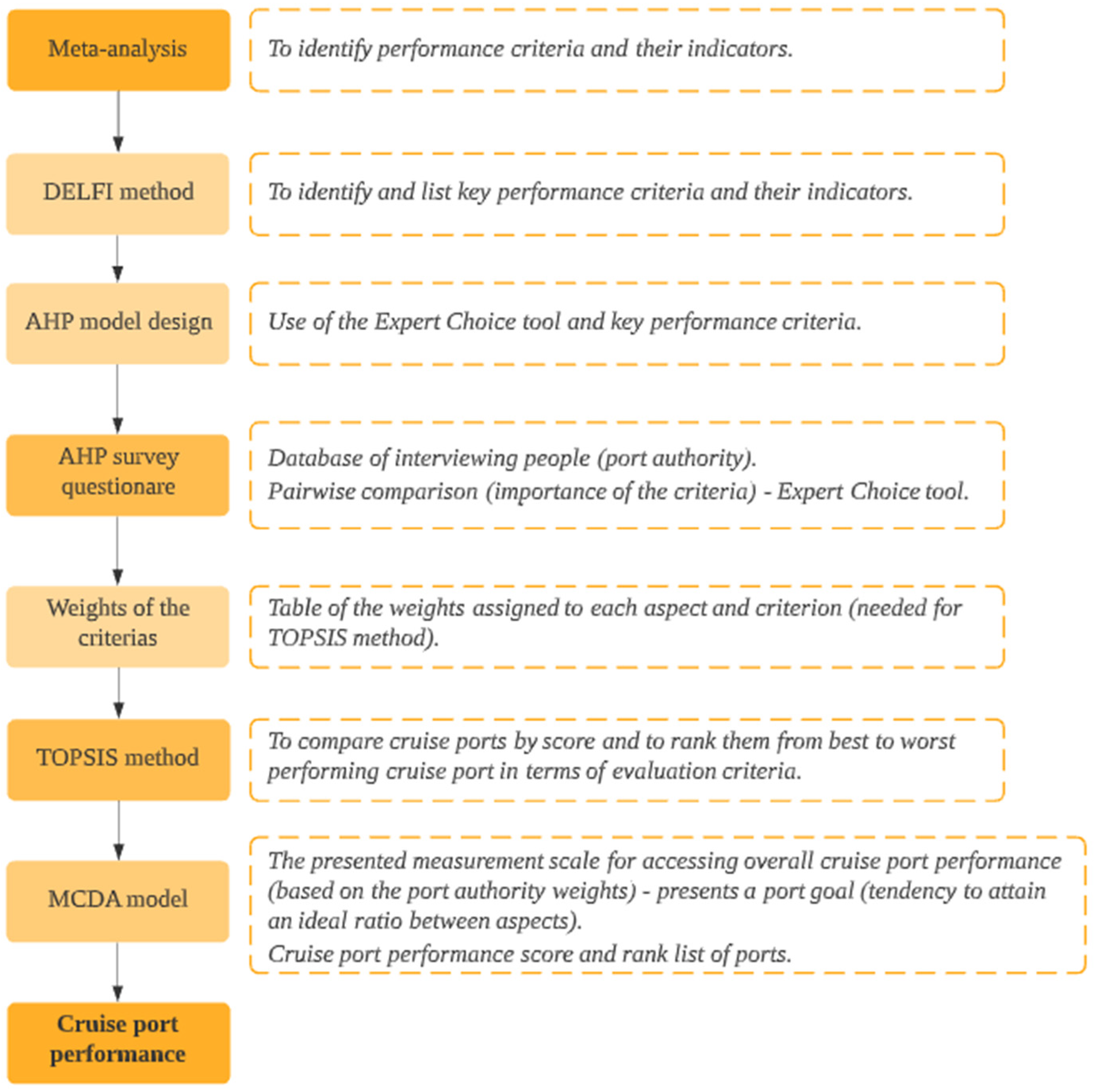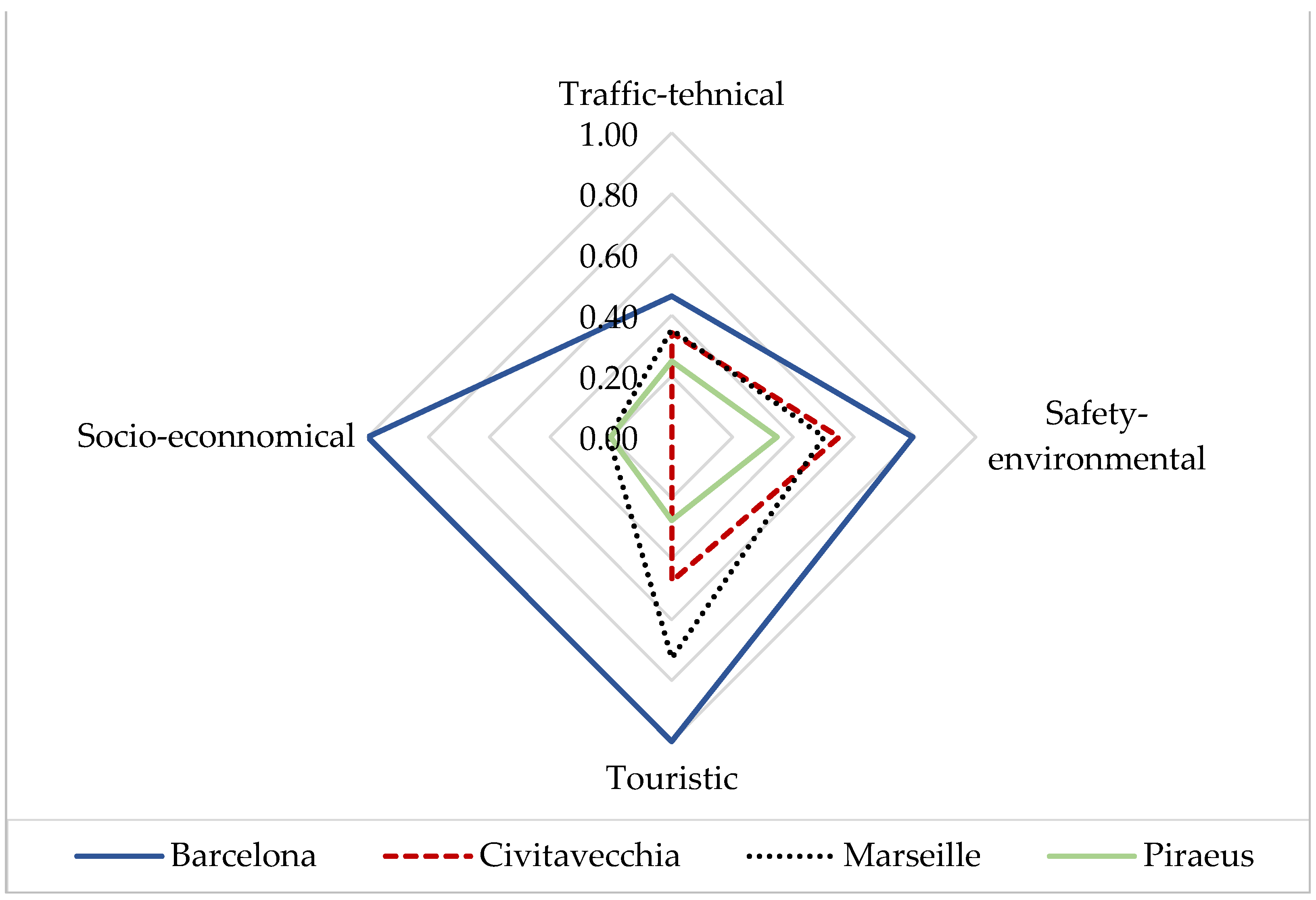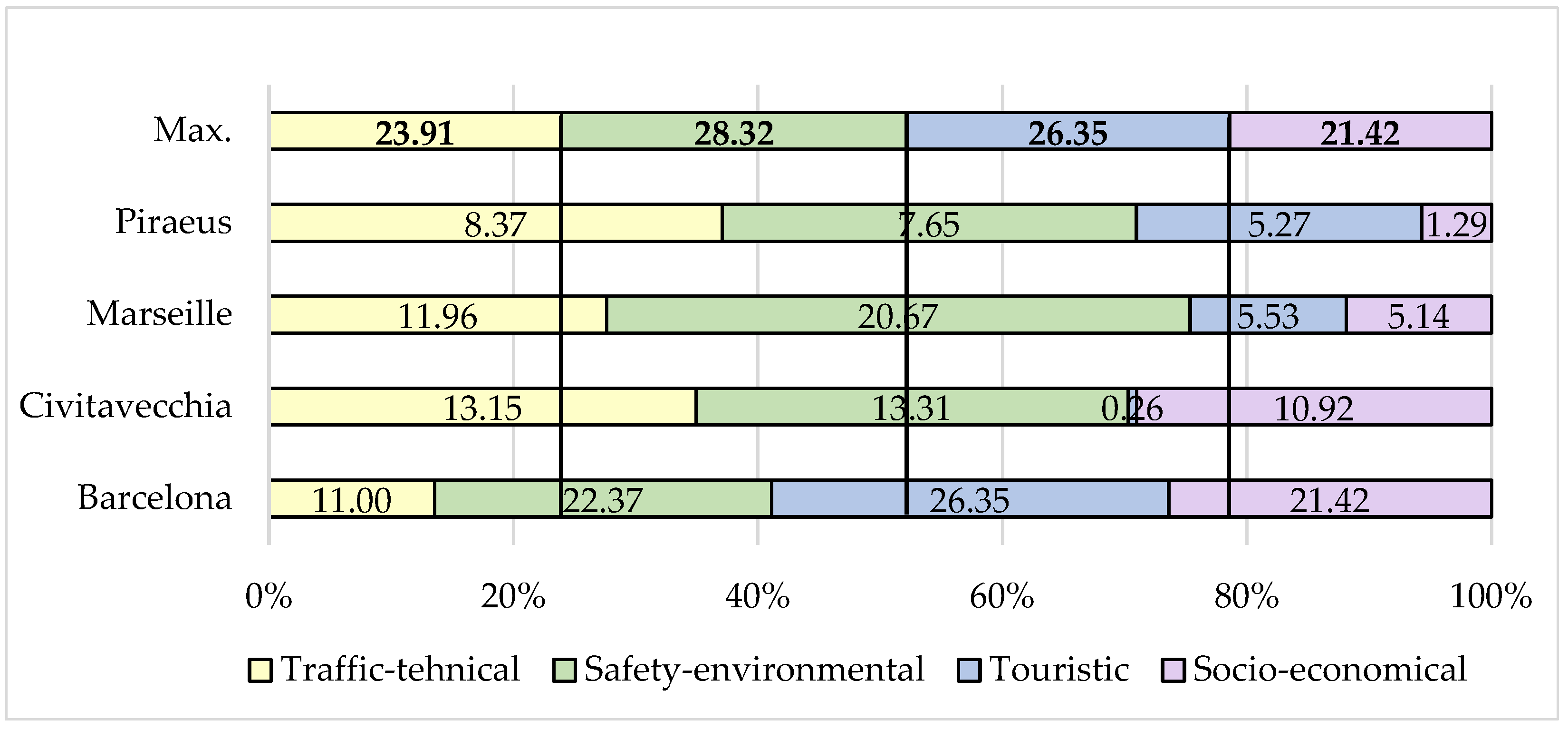Cruise Port Performance Evaluation in the Context of Port Authority: An MCDA Approach
Abstract
:1. Introduction
2. Multi-Criteria Decision-Making Model for Cruise Port Performance Evaluation
2.1. Traffic–Technical Aspect
2.2. Safety–Environmental Aspect
2.3. Touristic Aspect
2.4. Socioeconomic Aspect
2.5. The Formulation and Application of the Multi-Criteria Decision-Making Model
(tz · Utz + ta · Uta) + (za · Uza + dp · Udp + pp · Upp)
3. Case Study Application of the Proposed Multi-Criteria Decision-Making Model
3.1. Analytic Hierarchy Process (AHP) and Weights of Performance Evaluation Criteria
| Criteria\Weight | Port Authorities | Rank |
|---|---|---|
| A. Traffic–technical aspect | 23.91 | |
| 1. Traffic flow | 6.38 | 9 |
| 2. Accessibility | 7.19 | 8 |
| 3. Infrastructure | 10.34 | 4 |
| B. Safety–environmental aspect | 28.32 | |
| 4. Pollution | 6.27 | 10 |
| 5. Health care | 10.38 | 3 |
| 6. Safety and security | 11.67 | 2 |
| C. Touristic aspect | 26.35 | |
| 7. Tourism amenity | 7.30 | 6 |
| 8. Tourism attraction | 19.05 | 1 |
| D. Socioeconomic aspect | 21.42 | |
| 9. Employment | 9.18 | 5 |
| 10. Direct income | 7.30 | 6 |
| 11. Port fees | 4.94 | 11 |
3.2. The Technique of Order Preference Similarity to the Ideal Solution (TOPSIS)
| Indicator | Parameter | Best Practices | Parameter Value |
|---|---|---|---|
| 1.1 Number of cruise ship calls | Total number of cruise ship calls (home port, port of call). | Barcelona | 830 |
| 1.2 Number of cruise passengers | Total number of cruise passengers (embarked, disembarked, and transit passengers). | Barcelona | 3,041,963 |
| 2.1 Accessibility by public transport | Number of transit stops/stations within 2 km of the cruise terminal. | Barcelona | 292 |
| 2.2 Accessibility by bike and walking | Length of pedestrian paths in a 2 km radius from the cruise terminal. | Barcelona | 408.93 |
| 2.3 Accessibility by car | Number of parking lots within 2 km of the cruise terminal. | Marseille | 14,546 |
| 3.1 Port passenger terminal | Number of the present passenger terminal, else 0. | Barcelona | 7 |
| 3.2 Number of berths | Total number of berths, else 0. | Civitavecchia | 33 |
| 3.3 Cruise ship draft | Maximum allowed draft of a cruise ship in port (meters). | Civitavecchia | 18 |
| 4.1 Pollution index | Survey results. | Piraeus | 57.95 |
| 4.2 Waste | The amount of solid waste that the cruise port receives from cruise ships (tons). | Piraeus | 64,381 |
| 5.1 Health care | Survey results. | Marseille | 83.69 |
| 6.1 Crime index | Survey results. | Marseille | 56.96 |
| 7.1 Tourism amenity | Number of tourism amenities within 2 km of the cruise terminal. | Barcelona | 3,982 |
| 8.1 Tourism attraction | Number of tourist attractions within 2 km of the cruise terminal. | Barcelona | 549 |
| 9.1 Employment | Number of jobs in the region generated indirectly due to the cruise passengers. | Barcelona | 5,476 |
| 10.1 Direct income | Calculated expenditures of cruise passengers in the port city. | Barcelona | 125.78 |
| 11.1 Port fees | Port income from fees paid by the cruise ship for each passenger embarking, disembarking, and transiting at the port. | Barcelona | 10.04 |
3.3. Measurement Scale of Cruise Port Performance and Case Study Results
3.4. Comparison of the Proposed MCDA Method with a Recent State-of-the-Art Method
4. Conclusions
Author Contributions
Funding
Informed Consent Statement
Conflicts of Interest
References
- MedCruise. MedCruise Statistic Report 2019. 2020. Available online: http://www.medcruise.com/ (accessed on 18 February 2022).
- Wang, Y.; Jung, K.-A.; Yeo, G.-T.; Chou, C.-C. Selecting a cruise port of call location using the fuzzy-AHP method: A case study in East Asia. Tour. Manag. 2014, 42, 262–270. [Google Scholar] [CrossRef]
- Pallis, A. Working Paper: Cruise Shipping and Urban Development: State of the at of the Industry and Cruise Ports; No. 2015-14; OECD: Paris, France, 2015. [Google Scholar]
- Rodrigue, J.-P.; Notteboom, T. The geography of cruises: Itineraries, not destinations. Appl. Geogr. 2013, 38, 31–42. [Google Scholar] [CrossRef]
- Rodrigue, J.-P.; Notteboom, T. The geography of cruise shipping: Itineraries, capacity deployment and ports of call. In Proceedings of the International Association of Maritime Economists (IAME) 2012 Conference, Taipei, Taiwan, 5–8 September 2012; pp. 6–8. [Google Scholar]
- Marti, B.E. Shift-share analysis and port geography: A New England example. Marit. Policy Manag. 1982, 9, 241–250. [Google Scholar] [CrossRef]
- Notteboom, T.E. Concentration and load centre development in the European container port system. J. Transp. Geogr. 1997, 5, 99–115. [Google Scholar] [CrossRef]
- Esteve-Perez, J.; Garcia-Sanchez, A. Dynamism Patterns of Western Mediterranean Cruise Ports and the Coopetition Relationships Between Major Cruise Ports. Pol. Marit. Res. 2018, 25, 51–60. [Google Scholar] [CrossRef] [Green Version]
- Vaio, A.D.; Medda, F.; Trujillo, L. An analysis of the efficiency of italian cruise terminals. Int. J. Transp. Econ. 2011, 38, 1000–1018. [Google Scholar]
- Dowling, R.; Weeden, C. Cruise Ship Tourism, 2nd ed.; CABI: Oxfordshire, UK, 2017. [Google Scholar]
- Monpanthong, P. Efficiency of Cruise Port Management: A Comparison of Phuket and Singapore. Pertanika J. Soc. Sci. Humanit. 2018, 26, 22. [Google Scholar]
- Vaggelas George, K. Measurement of port performance from users’ perspective. Marit. Bus. Rev. 2019, 4, 130–150. [Google Scholar] [CrossRef]
- Kofjač, D.; Škurić, M.; Dragović, B.; Škraba, A. Traffic Modelling and Performance Evaluation in the Kotor Cruise Port. Stroj. Vestn.-J. Mech. Eng. 2013, 9, 526–535. [Google Scholar] [CrossRef]
- Lorenčič, V.; Twrdy, E.; Giuffrida, N.; Ignaccolo, M.; Inturri, G. Measuring and evaluating the performance of cruise ports with a multicriteria approach. In Proceedings of the 19th International Conference on Transport Science, Portoroz, Slovenia, 17–18 September 2020; Zanne, M., Bajec, P., Twrdy, E., Eds.; Faculty of Maritime Studies and Transport: Portoroz, Slovenia, 2020; pp. 185–192. [Google Scholar]
- Martel, J.-M.; Matarazzo, B. Other Outranking Approaches. In Multiple Criteria Decision Analysis: State of the Art Surveys; Figueira, J., Greco, S., Ehrogott, M., Eds.; Springer: New York, NY, USA, 2005; pp. 197–259. [Google Scholar] [CrossRef]
- Demirel, N.Ç.; Yücenur, G.N. The Cruise Port Place Selection Problem with Extended VIKOR and ANP Methodologies under Fuzzy Environment. In Proceedings of the World Congress on Engineering 2011, London, UK, 6–8 July 2011. [Google Scholar]
- Wudhikarn, R. Improving the intellectual capital management approach using the hybrid decision method. J. Intellect. Cap. 2018, 19, 670–691. [Google Scholar] [CrossRef]
- Samiappan, S.; Shamaskin, A.; Liu, J.; Linhoss, A.; Evans, K. Strategic Conservation of Gulf Coast Landscapes Using Multi-Criteria Decision Analysis and Open Source Remote Sensing and GIS Data. In Proceedings of the IGARSS 2020—2020 IEEE International Geoscience and Remote Sensing Symposium, Waikoloa, HI, USA, 26 September–2 October 2020; IEEE: Piscataway Township, NJ, USA, 2020; pp. 6662–6665. [Google Scholar]
- Zhang, R.; Yang, S.; Zhang, Q.; Xu, L.; He, Y.; Zhang, F. Graph-based few-shot learning with transformed feature propagation and optimal class allocation. Neurocomputing 2021, 470, 247–256. [Google Scholar] [CrossRef]
- Lee, P.; Yang, Z. Multi-Criteria Decision Making in Maritime Studies and Logistics; Applications and Cases; Springer: Berlin/Heidelberg, Germany, 2018. [Google Scholar]
- Kang, S.; Lee, S.M. A Policy Decision Process for Construction of Public Transportation City Model: Case Study of Jeju, Korea. In Proceedings of the 2007 International Conference on Multimedia and Ubiquitous Engineering (MUE’07), Seoul, Korea, 26–28 April 2007; pp. 477–483. [Google Scholar]
- Niaraki, A.S.; Kim, K. Ontology based personalized route planning system using a multi-criteria decision making approach. Expert Syst. Appl. 2009, 36, 2250–2259. [Google Scholar] [CrossRef]
- Sharifi, M.A.; Boerboom, L.; Shamsudin, K.B.; Veeramuthu, L. Spatial multiple criteria decision analysis in integrated planning for public transport and land use development study in Klang Valley, Malaysia. In Proceedings of the ISPRS Technical Commission II Symposium, Vienna, Austria, 12–14 July 2006; pp. 12–14. [Google Scholar]
- Olba, X.B.; Daamen, W.; Vellinga, T.; Hoogendoorn, S.P. Multi-criteria evaluation of vessel traffic for port assessment: A case study of the Port of Rotterdam. Case Stud. Transp. Policy 2019, 7, 871–881. [Google Scholar] [CrossRef]
- Qureshi, M.R.; Kumar, P.; Kumar, D. Framework for benchmarking logistics performance using fuzzy AHP. Int. J. Bus. Perform. Supply Chain Model. 2009, 1, 82. [Google Scholar] [CrossRef]
- Gerçek, H.; Karpak, B.; Kılınçaslan, T. A multiple criteria approach for the evaluation of the rail transit networks in Istanbul. Transportation 2004, 31, 203–228. [Google Scholar] [CrossRef]
- Lambas, M.E.L.; Giuffrida, N.; Ignaccolo, M.; Inturri, G. Comparison between bus rapid transit and light-rail transit systems: A multi-criteria decision analysis approach. Urban Transp. XXIII 2017, 176, 143. [Google Scholar]
- Macharis, C.; Bernardini, A. Reviewing the use of Multi-Criteria Decision Analysis for the evaluation of transport projects: Time for a multi-actor approach. Transp. Policy 2015, 37, 177–186. [Google Scholar] [CrossRef]
- Rezaei, J.; Palthe, L.V.W.; Tavasszy, L.; Wiegmans, B.; Van Der Laan, F. Port performance measurement in the context of port choice: An MCDA approach. Manag. Decis. 2019, 57, 396–417. [Google Scholar] [CrossRef] [Green Version]
- Ha, M.-H.; Yang, Z. Comparative analysis of port performance indicators: Independency and interdependency. Transp. Res. Part A Policy Pract. 2017, 103, 264–278. [Google Scholar] [CrossRef]
- Theo, N.; Athanasios, P.; Jean-Paul, R. Port Economics, Management and Policy, 1st ed.; Routledge: London, UK, 2022; p. 690. [Google Scholar]
- Baird, A.J. An investigation into the suitability of an enclosed seaport for cruise ships the case of Leith. Marit. Policy Manag. 1997, 24, 31–43. [Google Scholar] [CrossRef]
- Lorenčič, V.; Twrdy, E.; Batista, M. Development of Competitive—Cooperative Relationships among Mediterranean Cruise Ports since 2000. J. Mar. Sci. Eng. 2020, 8, 374. [Google Scholar] [CrossRef]
- Sciozzi, D.; Jugović, T.P.; Jugović, A. Structural analysis of cruise passenger traffic in the world and in the Republic of Croatia. Pomorstvo 2015, 29, 8–15. [Google Scholar]
- Maiorov, N.; Fetisov, V. Improvement of the quality of the sea passenger terminal based on methods of forecasting. Naše More 2018, 65, 135–140. [Google Scholar] [CrossRef]
- Lorenčič, V.; Twrdy, E. Forecasting cruise passenger demand in Mediterranean cruise ports. In Proceedings of the International Conference of Maritime Science & Technology Naše More 2019, Dubrovnik, Croatia, 17–18 October 2019; Maritime Department, University of Dubrovnik: Dubrovnik, Croatia, 2019. [Google Scholar]
- Çuhadar, M.; Cogurcu, I.; Kukrer, C. Modelling and Forecasting Cruise Tourism Demand to Izmir by Different Artificial Neural Network Architectures. Int. J. Bus. Soc. Res. 2014, 4, 12–28. [Google Scholar]
- Lekakou, M.; Pallis, A.; Vaggelas, G. Which homeport in Europe: The cruise industry’s selection criteria. Tourismos 2009, 4, 215–240. [Google Scholar]
- Papachristou, A.A.; Pallis, A.A.; Vaggelas, G.K. Cruise home-port selection criteria. Res. Transp. Bus. Manag. 2020, 100584, (Available online 6 November 2020, in press, Corrected Proof). [Google Scholar] [CrossRef]
- Lohvinenko, V.; Rossolov, A. Evaluation of Transport Accessibility of the Public Transport Network on the Basis of Stop Points Parametrization; Cracow University of Technology: Krakow, Poland, 2019. [Google Scholar]
- Iacono, M.; Krizek, K.J.; El-Geneidy, A. Measuring non-motorized accessibility: Issues, alternatives, and execution. J. Transp. Geogr. 2010, 18, 133–140. [Google Scholar] [CrossRef] [Green Version]
- Tawes, K. Duluth Superior cruise ship terminal facility study. In Preliminary Site Assessment for the Arrowhead Regional Development Commission Duluth Superior Metropolita Interstate Council (ARDC/MIC); ARDC/MIC: Duluth, MN, USA, 2013; Available online: https://dsmic.org/wp-content/uploads/2017/01/Duluth-Superior-Cruise-Ship-Terminal-Study.pdf (accessed on 14 February 2022).
- Marti, B.E. Geography and the cruise ship port selection process. Marit. Policy Manag. 1990, 17, 157–164. [Google Scholar] [CrossRef]
- Paiano, A.; Crovella, T.; Lagioia, G. Managing sustainable practices in cruise tourism: The assessment of carbon footprint and waste of water and beverage packaging. Tour. Manag. 2020, 77, 104016. [Google Scholar] [CrossRef]
- Asero, V.; Skonieczny, S. Cruise Tourism and Sustainability in the Mediterranean. Destination Venice. In Mobilities, Tourism and Travel Behavior—Contexts and Boundaries; InTechOpen Limited: London, UK, 2018. [Google Scholar] [CrossRef] [Green Version]
- Carić, H. Direct pollution cost assessment of cruising tourism in the Croatian Adriatic. Financ. Theory Pract. 2010, 34, 161–180. [Google Scholar]
- Toscano, D.; Murena, F. Atmospheric ship emissions in ports: A review. Correlation with data of ship traffic. Atmos. Environ. X 2019, 4, 100050. [Google Scholar] [CrossRef]
- Numbeo. 2020. Available online: https://www.numbeo.com/ (accessed on 14 February 2022).
- Johnson, D. Environmentally sustainable cruise tourism: A reality check. Mar. Policy 2002, 26, 261–270. [Google Scholar] [CrossRef]
- Butt, N. The impact of cruise ship generated waste on home portsand ports of call: A study of Southampton. Mar. Policy 2007, 31, 591–598. [Google Scholar] [CrossRef]
- Slišković, M.; Ukić, H.; Božić, K. Assessment of Solid Waste from Cruise Ships in the Port of Split. Trans. Marit. Sci. 2016, 5, 155–160. [Google Scholar] [CrossRef] [Green Version]
- Presburger Ulniković, V.; Vukić, M.; Milutinović-Nikolić, A. Analysis of solid waste from ships and modeling of its generation on the river Danube in Serbia. Waste Manag. Res. 2013, 31, 618–624. [Google Scholar] [CrossRef]
- Seabra, F.; Beck, A.L.; Manfredini, D.; Muller, M. Do Tourist Attractions of An Itinerary Pull Cruise Ship Lines? A Logit Model Estimation for Southern Hemisphere Destinations. Tour. Plan. Dev. 2019, 17, 37–45. [Google Scholar] [CrossRef]
- Lau, Y.-Y.; Yip, T.L. The Asia cruise tourism industry: Current trend and future outlook. Asian J. Shipp. Logist. 2020, 36, 202–213. [Google Scholar] [CrossRef]
- Pesce, M.; Terzi, S.; Al-Jawasreh, R.I.M.; Bommarito, C.; Calgaro, L.; Fogarin, S.; Russo, E.; Marcomini, A.; Linkov, I. Selecting sustainable alternatives for cruise ships in Venice using multi-criteria decision analysis. Sci. Total Environ. 2018, 642, 668–678. [Google Scholar] [CrossRef] [PubMed]
- CLIA. Reports—Cruise Industry Outlook; State of the Industry; CLIA: London, UK, 2019. [Google Scholar]
- Commission, E. Tourist Facilities in Ports. The Economic Factor. 2009, Directorate-General for Maritime Affairs and Fisheries; Policy Research Corporation: Rotterdam, The Netherlands, 2009; p. 65. [Google Scholar]
- Brida, J.G.; Scuderi, R. Determinants of tourist expenditure: A review of microeconometric models. Tour. Manag. Perspect. 2013, 6, 28–40. [Google Scholar] [CrossRef] [Green Version]
- Brida, J.G.; Zapata, S. Cruise tourism: Economic, socio-cultural and environmental impacts. Int. J. Leis. Tour. Mark. 2010, 1, 205. [Google Scholar] [CrossRef]
- Chase, G.; Alon, I. Evaluating the Economic Impact of Cruise Tourism: A Case Study of Barbados. Anatolia 2002, 13, 5–18. [Google Scholar] [CrossRef]
- Vayá, E.; Garcia, J.R.; Murillo, J.; Romaní, J.; Suriñach, J. Economic impact of cruise activity: The case of Barcelona. J. Travel Tour. Mark. 2018, 35, 479–492. [Google Scholar] [CrossRef]
- Stefanidaki, E.; Lekakou, M. Generated Economic Impact on Cruise Destinations: The Piraeus Case. In Cruise Tourism and Society; A Socioeconomic Perspective; Springer: Berlin/Heidelberg, Germany, 2012; pp. 69–84. [Google Scholar]
- Papadopoulou, G.; Sambracos, E. Recent Evolution of Cruise Activities in European Ports of Embarkation: A Quantitative and Economic Approach; University Library of Munich: Munich, Germany, 2014. [Google Scholar]
- Douglas, N.; Douglas, N. Cruise ship passenger spending patterns in Pacific Island Ports. Int. J. Tour. Res. 2004, 6, 251–261. [Google Scholar] [CrossRef]
- Saaty, T.L. Relative measurement and its generalization in decision making why pairwise comparisons are central in mathematics for the measurement of intangible factors the analytic hierarchy/network process. RACSAM-Rev. Real Acad. Cienc. Exactas Fis. Nat. Ser. A Mat. 2008, 102, 251–318. [Google Scholar] [CrossRef]
- Higashi, O. Analytic Hierarchy Process for Evaluation of Public Transport Policy Design in Phnom Penh City. Proc. East. Asia Soc. Transp. Stud. 2013, 9, 17. [Google Scholar]
- Nosal, K.; Solecka, K. Application of AHP Method for Multi-criteria Evaluation of Variants of the Integration of Urban Public Transport. Transp. Res. Procedia 2014, 3, 269–278. [Google Scholar] [CrossRef] [Green Version]
- Ishizaka, A.; Nemery, P. Multi-Criteria Decision Analysis: Methods and Software; John Wiley & Sons: Hoboken, NJ, USA, 2013. [Google Scholar]
- Hwang, C.-L.; Yoon, K. Multiple Attribute Decision Making: Methods and Applications; Springer: New York, NY, USA, 1981. [Google Scholar]
- Acuña-Soto, C.; Liern, V.; Pérez-Gladish, B. Normalization in TOPSIS-based approaches with data of different nature: Application to the ranking of mathematical videos. Ann. Oper. Res. 2021, 296, 541–569. [Google Scholar] [CrossRef]






| Aspect | Criteria | Indicator | Parameter |
|---|---|---|---|
| Traffic—technical | 1. Traffic flow | 1.1 Number of cruise ship calls | The total number of cruise ship calls (home port, port of call). |
| 1.2 Number of cruise passengers | The total number of cruise passengers (embarked, disembarked, and transit passengers). | ||
| 2. Accessibility | 2.1 Accessibility by public transport | The number of transit stops/stations within 2 km of the cruise terminal. | |
| 2.2 Accessibility by bike and walking | The length of pedestrian paths within 2 km of the cruise terminal. | ||
| 2.3 Accessibility by car | The no. of parking lots within 2 km of the cruise terminal. | ||
| 3. Infrastructure | 3.1 Port passenger terminal | The no. of the present passenger terminal, else 0. | |
| 3.2 Number of berths | The total no. of berths, else 0. | ||
| 3.3 Cruise ship draft | The maximum allowed draft of a cruise ship in port (meters). | ||
| Safety—environmental | 4. Pollution | 4.1 Pollution index | Survey results. |
| 4.2 Waste | The amount of solid waste that the cruise port receives from cruise ships (tons). | ||
| 5. Health care | 5.1 Health care | Survey results. | |
| 6. Safety and security | 6.1 Crime index | Survey results. | |
| Touristic | 7. Tourism amenity | 7.1 Tourism amenity | The number of tourism amenities within 2 km of the cruise terminal. |
| 8. Tourism attraction | 8.1 Tourism attraction | The number of tourism attractions within 2 km of the cruise terminal. | |
| Socio-economic | 9. Employment | 9.1 Employment | The no. of jobs in the region generated indirectly due to cruise passengers. |
| 10. Direct income | 10.1 Direct income | The calculated expenditure of cruise passengers in the port city. | |
| 11. Port fees | 11. Port fees | Port income from fees paid by cruise ships for each passenger embarking, disembarking, and transiting the port. |
| Traffic–Technical | Safety–Environmental | Touristic | Socioeconomic | |
|---|---|---|---|---|
| Barcelona | 0.46 | 0.79 | 1.00 | 1.00 |
| Civitavecchia | 0.55 | 0.47 | 0.01 | 0.51 |
| Marseille | 0.50 | 0.73 | 0.21 | 0.24 |
| Piraeus | 0.35 | 0.27 | 0.20 | 0.06 |
| Traffic–Technical | Safety–Environmental | Touristic | Socioeconomic | |
|---|---|---|---|---|
| Barcelona | 3 | 1 | 1 | 1 |
| Civitavecchia | 1 | 3 | 4 | 2 |
| Marseille | 2 | 2 | 2 | 3 |
| Piraeus | 4 | 4 | 3 | 4 |
| Port\Aspect | PT | VO | T | SE | Score (%) | Rank |
|---|---|---|---|---|---|---|
| Barcelona | 11.00 | 22.37 | 26.35 | 21.42 | 81.14 | 1 |
| Civitavecchia | 13.15 | 13.31 | 0.26 | 10.92 | 37.65 | 3 |
| Marseille | 11.96 | 20.67 | 5.53 | 5.14 | 43.30 | 2 |
| Piraeus | 8.37 | 7.65 | 5.27 | 1.29 | 22.57 | 4 |
Publisher’s Note: MDPI stays neutral with regard to jurisdictional claims in published maps and institutional affiliations. |
© 2022 by the authors. Licensee MDPI, Basel, Switzerland. This article is an open access article distributed under the terms and conditions of the Creative Commons Attribution (CC BY) license (https://creativecommons.org/licenses/by/4.0/).
Share and Cite
Lorenčič, V.; Twrdy, E.; Lep, M. Cruise Port Performance Evaluation in the Context of Port Authority: An MCDA Approach. Sustainability 2022, 14, 4181. https://doi.org/10.3390/su14074181
Lorenčič V, Twrdy E, Lep M. Cruise Port Performance Evaluation in the Context of Port Authority: An MCDA Approach. Sustainability. 2022; 14(7):4181. https://doi.org/10.3390/su14074181
Chicago/Turabian StyleLorenčič, Vivien, Elen Twrdy, and Marjan Lep. 2022. "Cruise Port Performance Evaluation in the Context of Port Authority: An MCDA Approach" Sustainability 14, no. 7: 4181. https://doi.org/10.3390/su14074181







